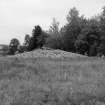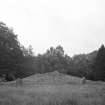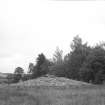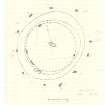Pricing Change
New pricing for orders of material from this site will come into place shortly. Charges for supply of digital images, digitisation on demand, prints and licensing will be altered.
Field Visit
Date 15 September 1943
Event ID 968090
Category Recording
Type Field Visit
Permalink http://canmore.org.uk/event/968090
Chambered cairn, Corrimony.
What the OS map describes as a stone circle stands on a dead-level, rather marshy meadow close to the road from Glen Urquhart to Corrimony about ½ mile due E of the old house. It is actually an intact cairn 8ft to 10ft [2.4m to 3m] high surrounded by a circle of 11 orthostats. The cairn consists almost entirely of rounded water-worn boulders covered in grass on its flanks but naked after the first couple of feet. Though the surface of the stony slope the top edges of five very large upright boulders just project on the SW and N while a sixth on the SW has been fully exposed by digging into the cairn and has fallen outwards as a result. These stones stand on the periphery of a circle of about 51ft [15.5m] diameter and presumably represent the peristalith of the cairn as they resemble the blocks in the peristalith on Clava and cairns of that group. The largest block visible on WSW is 5ft 6in [1.7m] long tangentially.
Cairn material certainly now extends well beyond this peristalith that does not interrupt the smooth slope from the cairns summit. The actual limits of the spread are naturally ill-defined; bare stones form an oval about 58ft [17.7m] E to W by 55ft [16.8m] N to S while under the turf the stones extent 74ft [22.6m] by 65ft [19.8m] reaching to the base of the orthostates on the W.
The 11 orthostats form a very irregular circle about 82ft [25m] N to S by 76ft [23.2m] E to W. The stones are set at intervals of from 15ft to 25ft [7.6m] save on the E where there is a gap if 35ft [10.7m]. A stone may have been removed from this point. A large slab that now lies prostrate on the summit of the cairn may once have stood here;* it measures 7ft 3in [2.2m] by 3ft 6in [1.1m] by 1ft 9in [0.5m] and bears on the exposed surface at least 44 cup-marks. The orthostat No. 10 on the WNW also bears five cup-marks on the face away from the cairn. [dimensions of orthostats given]
Though no chamber is exposed, the free-standing circle, the peristalith slabs and the cupmarks justify the inference that this in an intact cairn of the sort so familiar along the Nairn and Spey and on both sides of the Beauly Firth. As such the monument is certainly worthy of preservation though it does not seem to be in any danger.
Visited by RCAHMS (VG Childe), 15 September 1943
*For a suggestion that it may have been placed in its present position in 1830, cf PSAS, x, p.643













